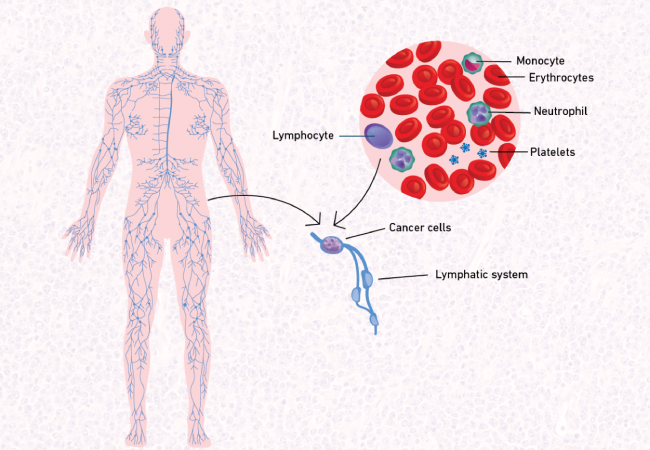Lymphoma is a type of cancer that starts in the body’s infection-fighting cells called lymphocytes, which are part of the immune system. These cancerous cells can develop from different types of lymphocytes, including B cells, T cells, or natural killer cells, at different stages of their growth. There are two main types of lymphoma: Hodgkin’s lymphoma and non-Hodgkin’s lymphoma (NHL), with NHL being the more common type, accounting for about 80% of all lymphomas.
Among NHL, the most common type is diffuse large B-cell lymphoma (DLBCL). B cells are a type of lymphocyte with various functions and the ability to change into different forms. Because of this diversity, NHL includes a wide range of diseases that differ in how they affect the body and how they look under a microscope. There are over 30 subtypes of NHL, but DLBCL is one of the most frequently diagnosed ones.
In simple terms, lymphoma is cancer that starts in certain white blood cells, and there are two main types: Hodgkin’s and non-Hodgkin’s lymphoma, with non-Hodgkin’s being more common. Within non-Hodgkin’s lymphoma, the most prevalent type is called diffuse large B-cell lymphoma (DLBCL). B cells, a type of white blood cell, can turn into cancerous cells in various ways, leading to different types of NHL.
What is Diffuse Large B-cell Lymphoma (DLBCL):
Diffuse large B-cell lymphoma (DLBCL) is a type of cancer that starts in white blood cells known as B cells. These B cells are a crucial part of the immune system, helping the body fight infections. In DLBCL, these B cells grow and multiply uncontrollably, forming tumors in different parts of the body, such as lymph nodes, bone marrow, or organs like the liver or spleen.
DLBCL is called “diffuse” because the cancer cells tend to spread throughout lymph nodes and other tissues rather than staying in one place. It’s called “large B-cell” because the cancer cells look big under a microscope and are a type of B-cell.
Diffuse large B-cell lymphoma (DLBCL) can happen to anyone, but it’s most common in people who are over 60 years old when they find out they have it.
Subtypes of Diffuse Large B-cell Lymphoma (DLBCL): There are two main subtypes of DLBCL, based on differences in lymphoma cells at the molecular level:
- Germinal Center B cell (GCB): This type of DLBCL starts in developing B cells.
- Activated B cell (ABC): This type starts in activated B cells and doesn’t respond well to standard DLBCL treatments.
Additional subtypes of Diffuse large B-cell lymphoma (DLBCL) with distinct features include:
- Double-expressor DLBCL: This subtype has both MYC and BCL2 proteins present, making it different from others.
- Double-hit or triple-hit DLBCL: These subtypes have specific genetic changes involving MYC, BCL2, and sometimes BCL6 genes.
- Primary extranodal DLBCL: This type starts outside the lymphatic system, like in the brain.
Primary mediastinal B-cell lymphoma: A rare DLBCL affecting the area between the lungs, mostly in young adults. - Epstein-Barr virus (EBV)-positive DLBCL of the elderly: This subtype occurs in older people and is linked to the Epstein-Barr virus.
- DLBCL not otherwise specified (NOS): This category covers a lot of DLBCL cases that don’t fit into specific subtypes.
- HIV-associated DLBCL: DLBCL linked to HIV infection.
- Posttransplant DLBCL: DLBCL that develops after organ or bone marrow transplant.
Each subtype may need different treatment approaches, so it’s important for doctors to know which subtype a patient has to provide the best care.
Symptoms of Diffuse Large B-Cell Lymphoma (DLBCL):
The main sign of diffuse large B-cell lymphoma (DLBCL) is a painless swelling in certain areas of the body, like your armpits, neck, belly, or groin. This swelling can happen quickly, sometimes in just a few weeks. About 1 in 3 people with DLBCL also have other symptoms, like:
- Fever
- Night sweats
- Unexpected weight loss
- Fatigue
- Severe itching
The signs and symptoms of DLBCL can mimic some other diseases, particularly autoimmune conditions.
Novel Treatment of Diffuse Large B-cell Lymphoma (DLBCL): Polivy (polatuzumab vedotin-piiq):
There’s a new treatment for a type of cancer called diffuse large B-cell lymphoma (DLBCL). It’s called Polivy, also known as polatuzumab vedotin-piiq. It is a CD79b-directed antibody and microtubule inhibitor conjugate used along with a rituximab product, cyclophosphamide, and prednisone (R-CHP) to treat adult patients who have previously untreated diffuse large B-cell lymphoma (DLBCL), not otherwise specified (NOS) or high-grade B-cell lymphoma (HGBL) and who have an International Prognostic Index score of 2 or greater.
The therapeutic drug is also used along with bendamustine and a rituximab product for the treatment of adult patients with relapsed or refractory DLBCL, NOS, after at least two prior therapies.
References:
https://ascopubs.org/doi/10.14694/EdBook_AM.2015.35.e449
https://www.ncbi.nlm.nih.gov/books/NBK557796/#:~:text=Healthcare%20Team%20Outcomes-,Diffuse%20large%20B%20cell%20lymphoma%20(DLBCL)%20is%20the%20most%20common,does%20respond%20well%20to%20chemotherapy.
https://www.rockymountaincancercenters.com/blog/understanding-a-diffuse-large-b-cell-lymphoma-dlbcl-diagnosis-what-you-need-to-know






